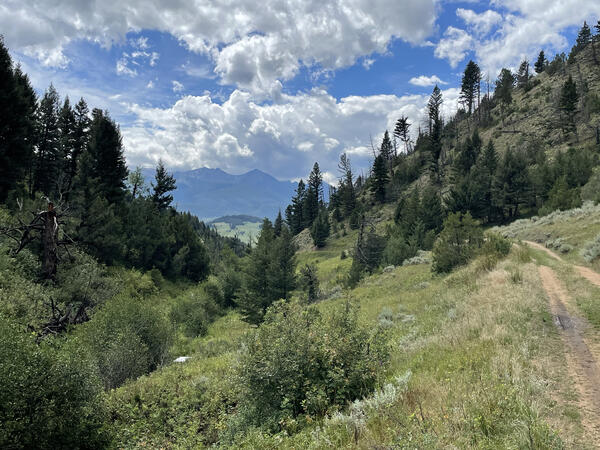Bison waiting by field technician's truck after a sample collection in Montana.
Lisa McKeon
Lisa McKeon is a physical scientist who has assisted with a wide array of climate related studies since joining the Climate Change in Mountain Ecosystems project in 1997.
Research Interest
Lisa provides project support for the USGS Benchmark Glacier Project creating outreach products and coordinating historic data preservation efforts.
Professional Experience
Physical scientist, USGS Northern Rocky Mountain Science Center, Bozeman, Montana, April 1997 - Present
Education and Certifications
B.A. Zoology. 1991. University of Washington, Seattle
Science and Products
Grinnell Glacier 1938-2019
Jackson Glacier 1941-2019
Kintla Glacier 1901-2019
Grinnell Glacier from Mount Gould, 1938 - 1981 - 1998 - 2015
Grinnell Ridge, Gem & Salamander Glaciers 1910 - 2017
Grinnell Glacier 1938 - 2016
Grinnell Glacier 1911 - 2016
Grinnell Glacier, circa 1888-2016
Time Series of Glacier Retreat
Climate Change in Mountain Ecosystems (CCME)
Vegetation - Hidden Lake (b)
Vegetation - Sperry Glacier
Scanned field notebooks from a USGS Benchmark Glacier: South Cascade Glacier, Washington,1957 - 2022
A comprehensive inventory of maximum glacial extent in Glacier National Park during the peak of the Little Ice Age
Geodetic Data for USGS Benchmark Glaciers: Orthophotos, Digital Elevation Models, Glacier Boundaries and Surveyed Positions
Glaciers of Glacier National Park Repeat Photography Collection
Glacier margin time series (1966, 1998, 2005, 2015) of the named glaciers of Glacier National Park, MT, USA
Bison waiting by field technician's truck after a sample collection in Montana.
A filter from the Smith-Root sampler that collects eDNA when water is pushed through. This pattern is indicative of turbid water passing through the filter.
A filter from the Smith-Root sampler that collects eDNA when water is pushed through. This pattern is indicative of turbid water passing through the filter.

An autonomous sampler (white box) is visible alongside a stream site in Montana
An autonomous sampler (white box) is visible alongside a stream site in Montana
USGS scientist shoots a repeat photograph of Grinnell Glacier in Glacier National Park to illustrate glacial recession due to impacts of climate change.
USGS scientist shoots a repeat photograph of Grinnell Glacier in Glacier National Park to illustrate glacial recession due to impacts of climate change.
READI-Net—Providing tools for the early detection and management of aquatic invasive species
U.S. Geological Survey Benchmark Glacier Project
The U.S. Geological Survey Benchmark Glacier Project combines decades of direct glaciological data with remote sensing data to advance the quantitative understanding of glacier-climate interactions. The global loss of glaciers, and consequent implications for water resources, sea level rise, and ecosystem function underscores the importance of U.S. Geological Survey glaciology research to facilit
Modeling and measuring snow for assessing climate change impacts in Glacier National Park, Montana
The Glacier - Climate Connection
The Glacier-Climate Connection geonarrative tells the story of the U.S. Geological Survey Benchmark Glacier Project, one of the longest running studies of glaciers on Earth.
Science and Products
Grinnell Glacier 1938-2019
Jackson Glacier 1941-2019
Kintla Glacier 1901-2019
Grinnell Glacier from Mount Gould, 1938 - 1981 - 1998 - 2015
Grinnell Ridge, Gem & Salamander Glaciers 1910 - 2017
Grinnell Glacier 1938 - 2016
Grinnell Glacier 1911 - 2016
Grinnell Glacier, circa 1888-2016
Time Series of Glacier Retreat
Climate Change in Mountain Ecosystems (CCME)
Vegetation - Hidden Lake (b)
Vegetation - Sperry Glacier
Scanned field notebooks from a USGS Benchmark Glacier: South Cascade Glacier, Washington,1957 - 2022
A comprehensive inventory of maximum glacial extent in Glacier National Park during the peak of the Little Ice Age
Geodetic Data for USGS Benchmark Glaciers: Orthophotos, Digital Elevation Models, Glacier Boundaries and Surveyed Positions
Glaciers of Glacier National Park Repeat Photography Collection
Glacier margin time series (1966, 1998, 2005, 2015) of the named glaciers of Glacier National Park, MT, USA
Bison waiting by field technician's truck after a sample collection in Montana.
Bison waiting by field technician's truck after a sample collection in Montana.
A filter from the Smith-Root sampler that collects eDNA when water is pushed through. This pattern is indicative of turbid water passing through the filter.
A filter from the Smith-Root sampler that collects eDNA when water is pushed through. This pattern is indicative of turbid water passing through the filter.

An autonomous sampler (white box) is visible alongside a stream site in Montana
An autonomous sampler (white box) is visible alongside a stream site in Montana
USGS scientist shoots a repeat photograph of Grinnell Glacier in Glacier National Park to illustrate glacial recession due to impacts of climate change.
USGS scientist shoots a repeat photograph of Grinnell Glacier in Glacier National Park to illustrate glacial recession due to impacts of climate change.
READI-Net—Providing tools for the early detection and management of aquatic invasive species
U.S. Geological Survey Benchmark Glacier Project
The U.S. Geological Survey Benchmark Glacier Project combines decades of direct glaciological data with remote sensing data to advance the quantitative understanding of glacier-climate interactions. The global loss of glaciers, and consequent implications for water resources, sea level rise, and ecosystem function underscores the importance of U.S. Geological Survey glaciology research to facilit
Modeling and measuring snow for assessing climate change impacts in Glacier National Park, Montana
The Glacier - Climate Connection
The Glacier-Climate Connection geonarrative tells the story of the U.S. Geological Survey Benchmark Glacier Project, one of the longest running studies of glaciers on Earth.
















